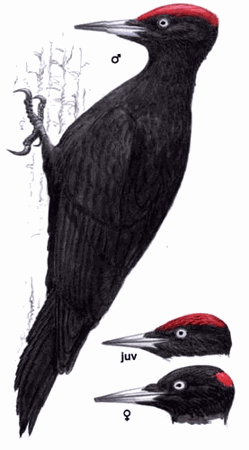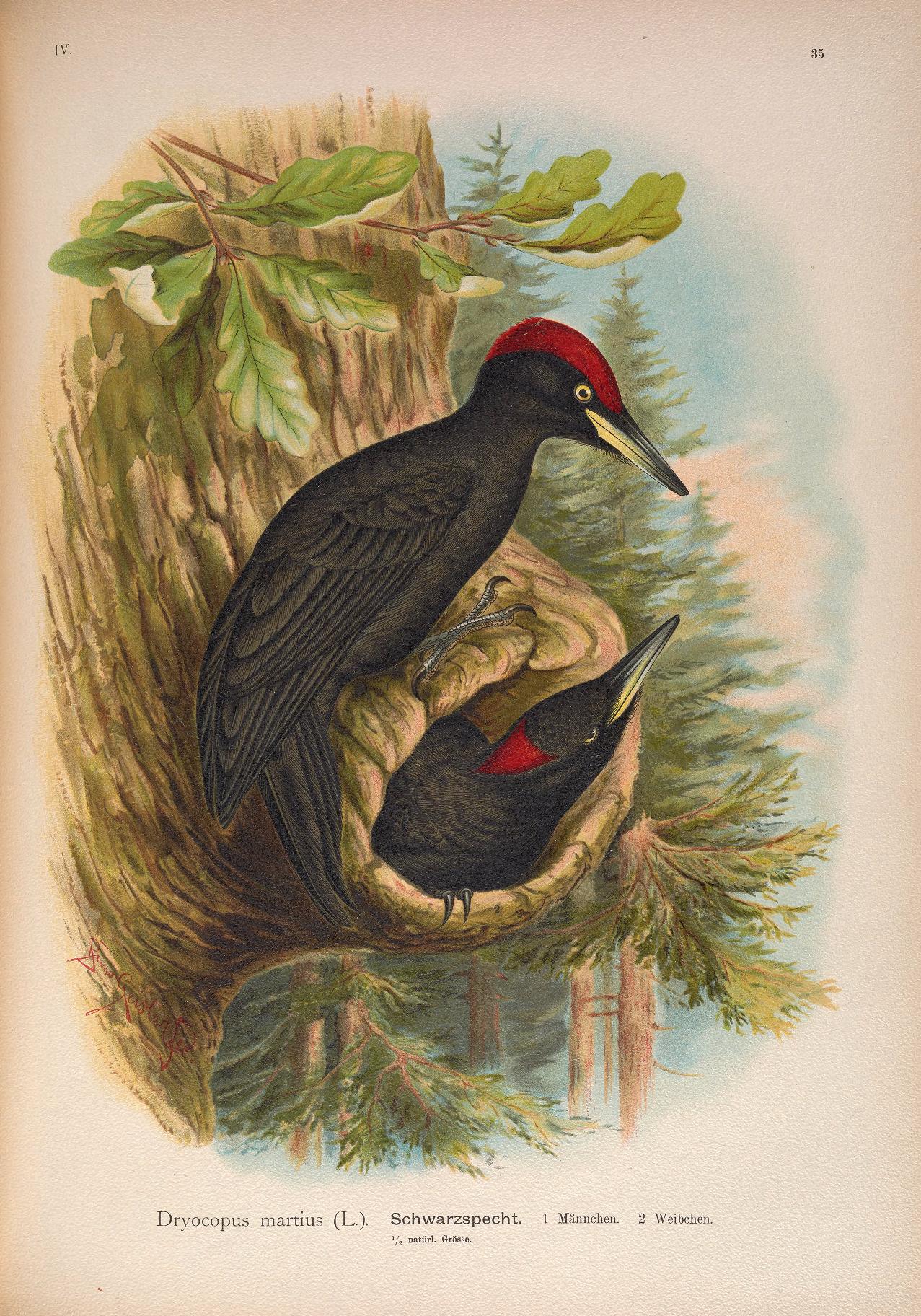[order] PICIFORMES | [family] Picidae | [latin] Dryocopus martius | [UK] Black Woodpecker | [FR] Pic noir | [DE] Schwarzspecht | [ES] Pito Negro | [NL] Zwarte Specht

Black Woodpecker
| Genus |
Species |
subspecies |
Breeding Range |
Breeding Range 2 |
Non Breeding Range |
| Campephilus |
martius |
|
|
|
|
| Dryocopus |
martius |
|
EU |
widespread |
|
| Dryocopus |
martius |
khamensis |
|
Tibet and sw China |
|
| Dryocopus |
martius |
martius |
|
w Europe to Kamchatka and Japan |
|
Powerful, crow-sized, all-black woodpecker with pale-based bill, white eye, and red crown (male) or rear crown patch (female). Flight flapping, recalling Nutcracker, mostly lacking undulations (until near perch) and rhythmical action. Drum roll loudest and longest of all woodpeckers.
Listen to the sound of Black Woodpecker
[audio:http://www.aviflevoland.nl/sounddb/B/Black Woodpecker.mp3]
Copyright remark: Most sounds derived from xeno-canto
| wingspan min.: |
70 |
cm |
wingspan max.: |
84 |
cm |
| size min.: |
44 |
cm |
size max.: |
54 |
cm |
| incubation min.: |
12 |
days |
incubation max.: |
14 |
days |
| fledging min.: |
24 |
days |
fledging max.: |
14 |
days |
| broods: |
1 |
|
eggs min.: |
3 |
|
| |
|
|
eggs max.: |
7 |
|
Eurasia : widespread
Favours tall trunks of climax forest, especially of mixed beech and fir, or of pure beech, but also of larch, spruce, Arolla pine, and other broad-leaved or coniferous trees, preferably well spaced but forming extensive unbroken forest. Also occurs in smaller stands separated from major forest by up to c. 4 km, and in winter wanders more widely, even to woodland near towns.
Egg laying in Central Europe from early April. Up to two weeks later in Scandinavia and northern Russia, one brood only. Site is a hole in tree or, less often, telegraph post. Wide variety of trees chosen, especially beech, pine, spruce, poplar, birch, willow, and alder. Height above ground 4-25 m. Nest is an excavated hole, with oval entrance 11-12 cm; depth 37-60 cm. Unlined, or with unremoved chips. Clutch size is 4-6 eggs incubated for 12-14 days, the young fledge after 24-28 days.
Mainly larvae, pupae, and adults of ants and wood-boring beetles. Bill bigger and stronger than in west Palearctic Picus woodpeckers, but tongue extends only c. 50-55 mm beyond bill-tip (compare Green Woodpecker). Tongue coated with viscous secretion from enlarged salivary glands; horny tip equipped with 4-5 pairs of backward-pointing barbs, enabling bird to impale and extract (e.g.) beetle larvae. Not infrequently on ground and will spend up to c. 2 hrs there, hopping from stump to stump. Rotten tree stumps hacked open with powerful blows of bill.
This species has an extremely large range, and hence does not approach the thresholds for Vulnerable under the range size criterion (Extent of Occurrence <20,000 km2 combined with a declining or fluctuating range size, habitat extent/quality, or population size and a small number of locations or severe fragmentation). The population trend appears to be increasing, and hence the species does not approach the thresholds for Vulnerable under the population trend criterion (>30% decline over ten years or three generations).

The population size is extremely large, and hence does not approach the thresholds for Vulnerable under the population size criterion (<10,000 mature individuals with a continuing decline estimated to be >10% in ten years or three generations, or with a specified population structure). For these reasons the species is evaluated as Least Concern.
Dryocopus martius is a widespread resident across much of Europe, which accounts for less than half of its global range. Its European breeding population is large (>740,000 pairs), and was stable between 1970-1990. Although there were declines in a few countries during 1990-2000, most populations?including the Russian stronghold?were stable or increased, and the species remained stable overall.
This large woodpecker has a wide distribution in deciduous, mixed and coniferous forests of Eurasia, from Spain and Scandinavia to China and Kamchatka. During the twentieth century it has extended its breeding area to western France, Belgium, the Netherlands and Denmark. This expansion is probably linked to the fact that the extensive conifer plantations in these areas have become mature. Elsewhere populations seem to be quite stable, and the total population of the European Union (12 Member States) is currently estimated at 90000-100000 breeding pairs

Resident in breeding range, but juveniles can disperse quite far.





1 Comment
Add a Comment